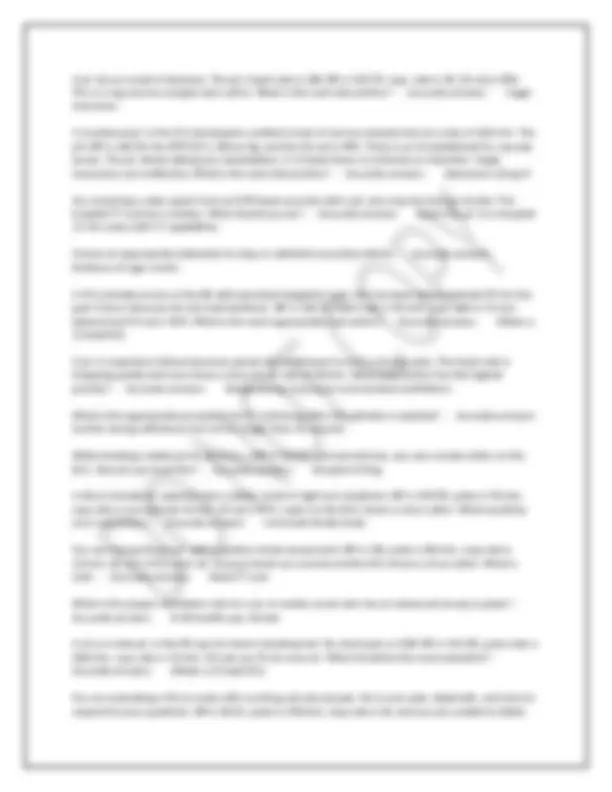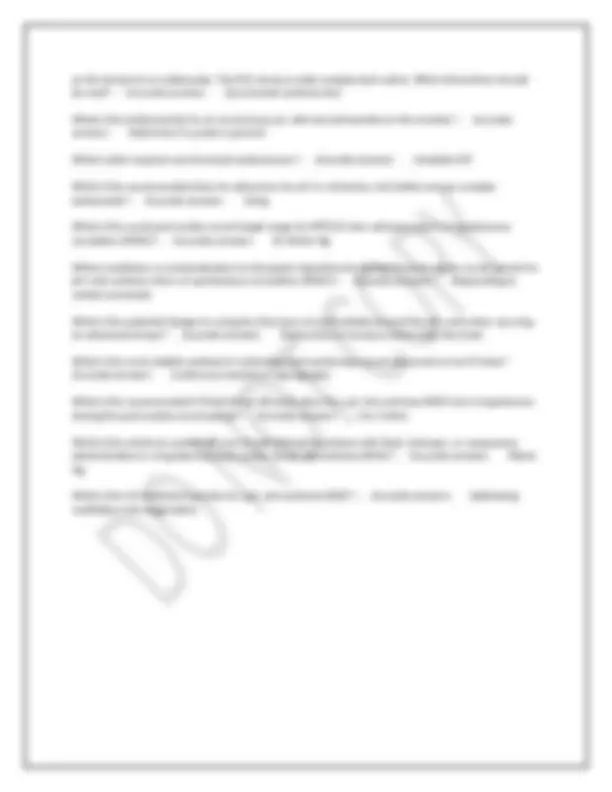




Study with the several resources on Docsity

Earn points by helping other students or get them with a premium plan


Prepare for your exams
Study with the several resources on Docsity

Earn points to download
Earn points by helping other students or get them with a premium plan
Community
Ask the community for help and clear up your study doubts
Discover the best universities in your country according to Docsity users
Free resources
Download our free guides on studying techniques, anxiety management strategies, and thesis advice from Docsity tutors
AHA ACLS WRITTEN TEST QUESTIONS WITH 100% ACCURATE ANSWERS
Typology: Exams
1 / 4

This page cannot be seen from the preview
Don't miss anything!



You find an unresponsive pt. who is not breathing. After activating the emergency response system, you determine there is no pulse. What is your next action? - Accurate answers Start chest compressions of at least 100 per min. You are evaluating a 58 year old man with chest pain. The BP is 92/50 and a heart rate of 92/min, non- labored respiratory rate is 14 breaths/min and the pulse O2 is 97%. What assessment step is most important now? - Accurate answers Obtaining a 12 lead ECG. What is the preferred method of access for epi administration during cardiac arrest in most pts? - Accurate answers Peripheral IV An AED does not promptly analyze a rythm. What is your next step? - Accurate answers Begin chest compressions. You have completed 2 min of CPR. The ECG monitor displays the lead below (PEA) and the pt. has no pulse. You partner resumes chest compressions and an IV is in place. What management step is your next priority? - Accurate answers Administer 1mg of epinepherine During a pause in CPR, you see a narrow complex rythm on the monitor. The pt. has no pulse. What is the next action? - Accurate answers Resume compressions What is acommon but sometimes fatal mistake in cardiac arrest management? - Accurate answers Prolonged interruptions in chest compressions. Which action is a componant of high-quality chest comressions? - Accurate answers Allowing complete chest recoil Which action increases the chance of successful conversion of ventricular fibrillation? - Accurate answers Providing quality compressions immediately before a defibrillation attempt. Which situation BEST describes PEA? - Accurate answers Sinus rythm without a pulse What is the best strategy for perfoming high-quality CPR on a pt.with an advanced airway in place? - Accurate answers Provide continuous chest compressionswithout pauses and 10 ventilations per minute. 3 min after witnessing a cardiac arrest, one memeber of your team inserts an ET tube while another performs continuous chest comressions. During subsequent bentilation, you notice the presence of a wavefom on the capnogrophy screen and a PETCO2 of 8 mm Hg. What is the significance of this finding?
The use of quantitative capnography in intubated pt's does what? - Accurate answers Allowsfor monitoring CPR quality For the past 25 min, EMS crews have attemptedresuscitation of a pt who originally presented with V-FIB. After the 1st shock, the ECG screen displayed asystole which has persisted despite 2 doses of epi, a fluid bolus, and high quality CPR. What is your next treatment? - Accurate answers Consider terminating resuscitive efforts after consulting medical control. Which is a safe and effective practice within the defibrillation sequence? - Accurate answers Be sure O2 is NOT blowing over the pt's chest during shock. During your assessment, your pt suddenly loses consciousness. After calling for help and determining that the pt. is not breathing, you are unsure whether the pt. has a pulse. What is your next action? - Accurate answers Begin chest compressions. What is an advantage of using hands-free d-fib pads instead of d-fib paddles? - Accurate answers Hands-free allows for more rapid d-fib. What action is recommended to help minimize interruptions in chest compressions during CPR? - Accurate answers Continue CPR while charging the defibrillator. Which action is included in the BLS survey? - Accurate answers Early defibrillation Which drug and dose are recommended for the management of a pt. in refractory V-FIB? - Accurate answers Amioderone 300mg What is the appropriate intervalfor an interruption in chest compressions? - Accurate answers 10 seconds or less Which of the following is a sign of effective CPR? - Accurate answers PETCO2 = or > 10mm Hg What is the primary purpose of a medical emergency team or rapid response team? - Accurate answers Identifying and treating early clinical deterioration. Which action improves the quality of chest compressions delivered during resuscitave attemepts? - Accurate answers Shitch providers about every 2 min or every 5 compression cycles. What is the appropriate ventilation strategy for an adult in respiratory arrest with a pulse of 80 beats/min? - Accurate answers 1 breath every 5-6 seconds A pt. presents to the ER with a new onset of dizziness and fatugue. Onexamination, the pt's heart rate is 35 beats/min, BP is 70/50, resp. rate is 22 per min, O2 sat is 95%. What is the appropriate 1st medication? - Accurate answers Atropine 0.5mg A pt. presents to the ER with dizziness and SOB with a sinus brady of 40/min. The initial atropine dose was ineffective and your monitor does not provide TCP. What is the appropriate dose of Dopamine for this pt? - Accurate answers 2-10mcg/kg/min
an 02 sat due to no radial pulse. The ECG shows a wide complex tach rythm. What intervention should be next? - Accurate answers Syncronized cardioversion. What is the initial priority for an unconscious pt. with any tachycardia on the monitor? - Accurate answers Determine if a pulse is present. Which rythm requires synchronized cardioversion? - Accurate answers Unstable SVT What is the recommended dose for adenosine for pt's in refractory, but stable narrow complex tachycardia? - Accurate answers 12mg What is the usual post-cardiac arrest target range for PETCO2 who achieves return of spontaneous circulation (ROSC)? - Accurate answers 35-40mm Hg Which conditionis a contraindication to theraputic hypothermia during the post-cardiac arrest period for pt's who achieve return of spontaneous circulation (ROSC)? - Accurate answers Responding to verbal commands What is the potential danger to using ties that pass circumfrentially around the pt's neck when securing an advanced airway? - Accurate answers Obstruction of veneous return from the brain What is the most reliable method of confirming and montioring correct placement of an ET tube? - Accurate answers Continuous waveform capnography What is the recommended IV fluid (NS or LR) bolus dose for a pt. who achieves ROSC but is hypotensive during the post-cardiac arrest period? - Accurate answers 1 to 2 Liters What is the minimum systolic BP one should attempt to achieve with fluid, Inotropic, or vasopressor administration in a hypotensive post-cardiac arrest who achieves ROSC? - Accurate answers 90mm Hg What is the 1st treatment priority for a pt. who achieves ROSC? - Accurate answers Optimizing ventilation and oxygenation.